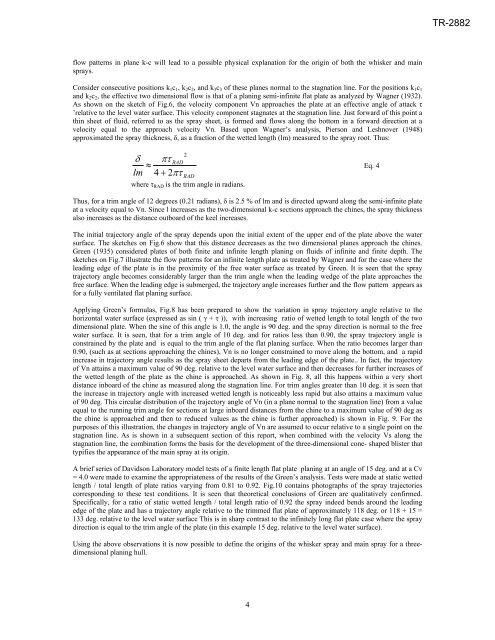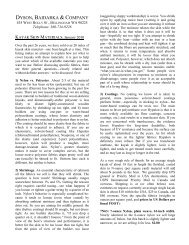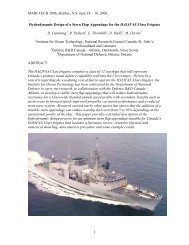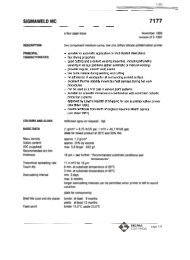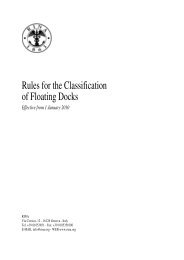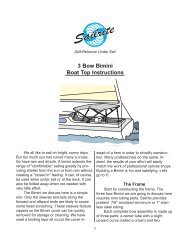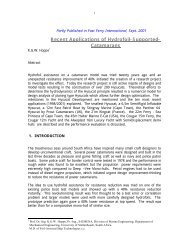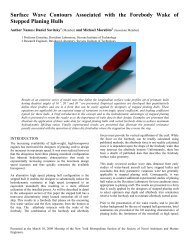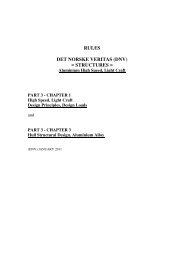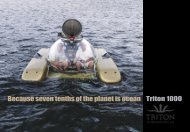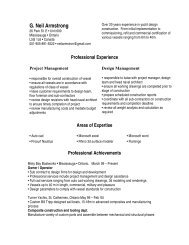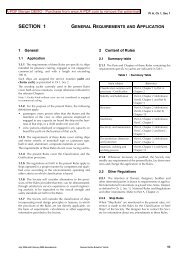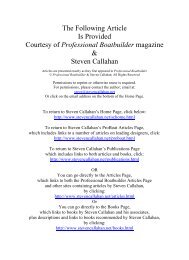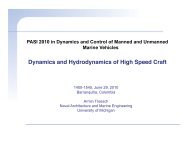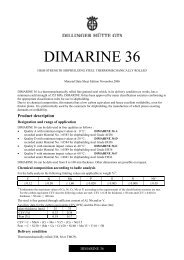Origin and Characteristics of the Spray Patterns TR-2882 3-10 ...
Origin and Characteristics of the Spray Patterns TR-2882 3-10 ...
Origin and Characteristics of the Spray Patterns TR-2882 3-10 ...
Create successful ePaper yourself
Turn your PDF publications into a flip-book with our unique Google optimized e-Paper software.
<strong>TR</strong>-<strong>2882</strong><br />
flow patterns in plane k-c will lead to a possible physical explanation for <strong>the</strong> origin <strong>of</strong> both <strong>the</strong> whisker <strong>and</strong> main<br />
sprays.<br />
Consider consecutive positions k 1 c 1 , k 2 c 2 , <strong>and</strong> k 3 c 3 <strong>of</strong> <strong>the</strong>se planes normal to <strong>the</strong> stagnation line. For <strong>the</strong> positions k 1 c 1<br />
<strong>and</strong> k 2 c 2 , <strong>the</strong> effective two dimensional flow is that <strong>of</strong> a planing semi-infinite flat plate as analyzed by Wagner (1932).<br />
As shown on <strong>the</strong> sketch <strong>of</strong> Fig.6, <strong>the</strong> velocity component Vn approaches <strong>the</strong> plate at an effective angle <strong>of</strong> attack τ<br />
’relative to <strong>the</strong> level water surface. This velocity component stagnates at <strong>the</strong> stagnation line. Just forward <strong>of</strong> this point a<br />
thin sheet <strong>of</strong> fluid, referred to as <strong>the</strong> spray sheet, is formed <strong>and</strong> flows along <strong>the</strong> bottom in a forward direction at a<br />
velocity equal to <strong>the</strong> approach velocity Vn. Based upon Wagner’s analysis, Pierson <strong>and</strong> Leshnover (1948)<br />
approximated <strong>the</strong> spray thickness, δ, as a fraction <strong>of</strong> <strong>the</strong> wetted length (lm) measured to <strong>the</strong> spray root. Thus:<br />
2<br />
δ πτ<br />
RAD<br />
≈ Eq. 4<br />
lm 4 + 2πτ<br />
RAD<br />
where τ RAD is <strong>the</strong> trim angle in radians.<br />
Thus, for a trim angle <strong>of</strong> 12 degrees (0.21 radians), δ is 2.5 % <strong>of</strong> lm <strong>and</strong> is directed upward along <strong>the</strong> semi-infinite plate<br />
at a velocity equal to Vn. Since l increases as <strong>the</strong> two-dimensional k-c sections approach <strong>the</strong> chines, <strong>the</strong> spray thickness<br />
also increases as <strong>the</strong> distance outboard <strong>of</strong> <strong>the</strong> keel increases.<br />
The initial trajectory angle <strong>of</strong> <strong>the</strong> spray depends upon <strong>the</strong> initial extent <strong>of</strong> <strong>the</strong> upper end <strong>of</strong> <strong>the</strong> plate above <strong>the</strong> water<br />
surface. The sketches on Fig.6 show that this distance decreases as <strong>the</strong> two dimensional planes approach <strong>the</strong> chines.<br />
Green (1935) considered plates <strong>of</strong> both finite <strong>and</strong> infinite length planing on fluids <strong>of</strong> infinite <strong>and</strong> finite depth. The<br />
sketches on Fig.7 illustrate <strong>the</strong> flow patterns for an infinite length plate as treated by Wagner <strong>and</strong> for <strong>the</strong> case where <strong>the</strong><br />
leading edge <strong>of</strong> <strong>the</strong> plate is in <strong>the</strong> proximity <strong>of</strong> <strong>the</strong> free water surface as treated by Green. It is seen that <strong>the</strong> spray<br />
trajectory angle becomes considerably larger than <strong>the</strong> trim angle when <strong>the</strong> leading wedge <strong>of</strong> <strong>the</strong> plate approaches <strong>the</strong><br />
free surface. When <strong>the</strong> leading edge is submerged, <strong>the</strong> trajectory angle increases fur<strong>the</strong>r <strong>and</strong> <strong>the</strong> flow pattern appears as<br />
for a fully ventilated flat planing surface.<br />
Applying Green’s formulas, Fig.8 has been prepared to show <strong>the</strong> variation in spray trajectory angle relative to <strong>the</strong><br />
horizontal water surface (expressed as sin ( γ + τ )), with increasing ratio <strong>of</strong> wetted length to total length <strong>of</strong> <strong>the</strong> two<br />
dimensional plate. When <strong>the</strong> sine <strong>of</strong> this angle is 1.0, <strong>the</strong> angle is 90 deg. <strong>and</strong> <strong>the</strong> spray direction is normal to <strong>the</strong> free<br />
water surface. It is seen, that for a trim angle <strong>of</strong> <strong>10</strong> deg. <strong>and</strong> for ratios less than 0.90, <strong>the</strong> spray trajectory angle is<br />
constrained by <strong>the</strong> plate <strong>and</strong> is equal to <strong>the</strong> trim angle <strong>of</strong> <strong>the</strong> flat planing surface. When <strong>the</strong> ratio becomes larger than<br />
0.90, (such as at sections approaching <strong>the</strong> chines), Vn is no longer constrained to move along <strong>the</strong> bottom, <strong>and</strong> a rapid<br />
increase in trajectory angle results as <strong>the</strong> spray sheet departs from <strong>the</strong> leading edge <strong>of</strong> <strong>the</strong> plate.. In fact, <strong>the</strong> trajectory<br />
<strong>of</strong> Vn attains a maximum value <strong>of</strong> 90 deg. relative to <strong>the</strong> level water surface <strong>and</strong> <strong>the</strong>n decreases for fur<strong>the</strong>r increases <strong>of</strong><br />
<strong>the</strong> wetted length <strong>of</strong> <strong>the</strong> plate as <strong>the</strong> chine is approached. As shown in Fig. 8, all this happens within a very short<br />
distance inboard <strong>of</strong> <strong>the</strong> chine as measured along <strong>the</strong> stagnation line. For trim angles greater than <strong>10</strong> deg. it is seen that<br />
<strong>the</strong> increase in trajectory angle with increased wetted length is noticeably less rapid but also attains a maximum value<br />
<strong>of</strong> 90 deg. This circular distribution <strong>of</strong> <strong>the</strong> trajectory angle <strong>of</strong> Vn (in a plane normal to <strong>the</strong> stagnation line) from a value<br />
equal to <strong>the</strong> running trim angle for sections at large inboard distances from <strong>the</strong> chine to a maximum value <strong>of</strong> 90 deg as<br />
<strong>the</strong> chine is approached <strong>and</strong> <strong>the</strong>n to reduced values as <strong>the</strong> chine is fur<strong>the</strong>r approached) is shown in Fig. 9. For <strong>the</strong><br />
purposes <strong>of</strong> this illustration, <strong>the</strong> changes in trajectory angle <strong>of</strong> Vn are assumed to occur relative to a single point on <strong>the</strong><br />
stagnation line. As is shown in a subsequent section <strong>of</strong> this report, when combined with <strong>the</strong> velocity Vs along <strong>the</strong><br />
stagnation line, <strong>the</strong> combination forms <strong>the</strong> basis for <strong>the</strong> development <strong>of</strong> <strong>the</strong> three-dimensional cone- shaped blister that<br />
typifies <strong>the</strong> appearance <strong>of</strong> <strong>the</strong> main spray at its origin.<br />
A brief series <strong>of</strong> Davidson Laboratory model tests <strong>of</strong> a finite length flat plate planing at an angle <strong>of</strong> 15 deg. <strong>and</strong> at a Cv<br />
= 4.0 were made to examine <strong>the</strong> appropriateness <strong>of</strong> <strong>the</strong> results <strong>of</strong> <strong>the</strong> Green’s analysis. Tests were made at static wetted<br />
length / total length <strong>of</strong> plate ratios varying from 0.81 to 0.92. Fig.<strong>10</strong> contains photographs <strong>of</strong> <strong>the</strong> spray trajectories<br />
corresponding to <strong>the</strong>se test conditions. It is seen that <strong>the</strong>oretical conclusions <strong>of</strong> Green are qualitatively confirmed.<br />
Specifically, for a ratio <strong>of</strong> static wetted length / total length ratio <strong>of</strong> 0.92 <strong>the</strong> spray indeed bends around <strong>the</strong> leading<br />
edge <strong>of</strong> <strong>the</strong> plate <strong>and</strong> has a trajectory angle relative to <strong>the</strong> trimmed flat plate <strong>of</strong> approximately 118 deg. or 118 + 15 =<br />
133 deg. relative to <strong>the</strong> level water surface This is in sharp contrast to <strong>the</strong> infinitely long flat plate case where <strong>the</strong> spray<br />
direction is equal to <strong>the</strong> trim angle <strong>of</strong> <strong>the</strong> plate (in this example 15 deg. relative to <strong>the</strong> level water surface).<br />
Using <strong>the</strong> above observations it is now possible to define <strong>the</strong> origins <strong>of</strong> <strong>the</strong> whisker spray <strong>and</strong> main spray for a threedimensional<br />
planing hull.<br />
4


